- Transformation
- 15 min read
- January 2025
What Matters Most in Application Modernization?
Key Takeaways
Many enterprises underestimate how outdated applications silently erode efficiency until they lose market share. A leading manufacturer recently faced this reality: production delays mounted, inventory systems failed to keep up, and customer complaints surged.
Then came the wake-up call: a competitor, leveraging modern systems, began delivering faster, more reliable service. Leadership realized short-term fixes weren’t enough; they needed a strategic application modernization strategy to stay competitive.
This challenge is widespread. 80% of enterprises risk falling behind due to legacy applications, and 70% of digital transformation efforts stall because of outdated systems. Yet, organizations that take the right approach focusing on cloud adoption, automation, and data-driven decision-making achieve 2.5x higher efficiency and 85% stronger customer satisfaction.
So, what truly drives success when modernizing applications? Which strategies create real business value, and which add unnecessary complexity?
This guide breaks down the core priorities of application modernization, helping you make confident, future-ready decisions that enhance agility, efficiency, and long-term growth.
What is application modernization? A strategic imperative for business leaders
Defining application modernization
As businesses navigate digital transformation, outdated systems often become a bottleneck, limiting growth, efficiency, and innovation. Modernizing applications isn’t just about upgrading technology, it’s about future-proofing operations. Application modernization services help organizations enhance flexibility, optimize costs, and improve customer experiences by transforming legacy systems into cloud-native application modernization models.
Unlike costly rip-and-replace approaches, legacy application modernization focuses on reengineering existing applications to align with modern business needs. This involves adopting cloud environments, public, private, or hybrid, along with automation and AI-driven capabilities to maximize scalability and resilience.
Key components of an effective application modernization strategy
A well-defined application modernization strategy requires a structured approach and the right application modernization tools.
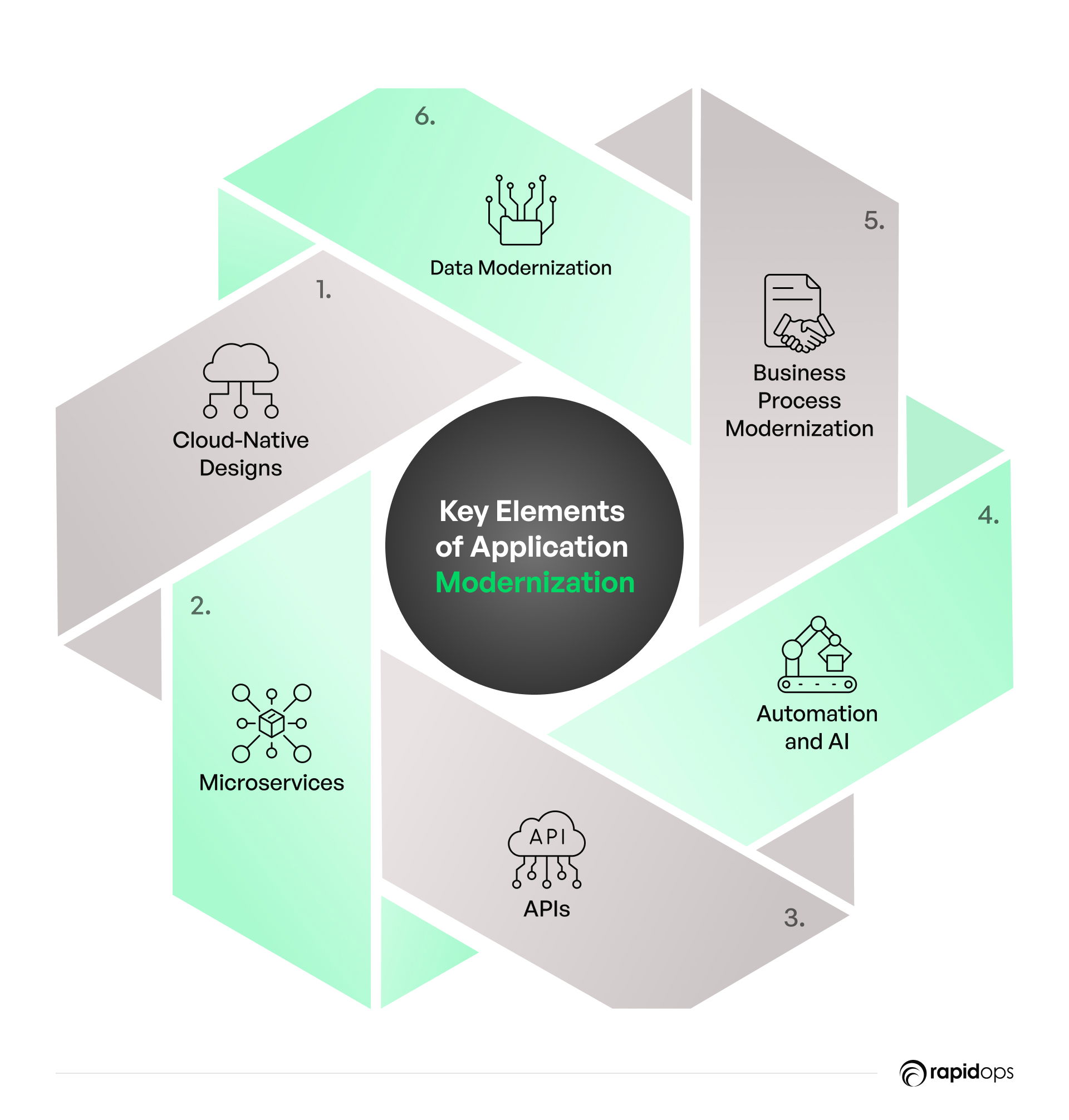
- Cloud-native architectures: Shift workloads to scalable, cost-efficient cloud platforms to enhance agility and reduce IT complexity.
- Microservices: Break monolithic applications into modular services, enabling faster innovation and seamless scaling.
- APIs and integrations: Ensure smooth interoperability between modern and legacy systems, improving collaboration and data accessibility.
- AI-driven application modernization: Automate workflows, enhance decision-making, and drive predictive insights to increase efficiency.
These modernization elements reduce technical debt while enabling businesses to leverage scalable application modernization for sustained growth.
Why it’s a strategic priority for business leaders
Application modernization isn’t just an IT initiative, it’s a business-driven application modernization strategy that accelerates innovation and market responsiveness. A strong enterprise modernization strategy helps organizations:
- Seize new business opportunities faster by leveraging scalable and adaptive technologies.
- Reduce operational risks by eliminating vulnerabilities in outdated systems.
- Enhance business resilience through cost-optimized, cloud-first infrastructure.
The path to future-ready modernization
Investing in future-ready application modernization ensures long-term competitiveness. Whether through cloud migration, process automation, or legacy system modernization, enterprises that modernize strategically are better positioned for sustainable growth, efficiency, and innovation.
Why application modernization matters: The business impact
Legacy systems pose challenges to competitiveness, scalability, and resilience, especially in today’s rapidly evolving markets. As technology advances, outdated infrastructure leads to inefficiencies, customer dissatisfaction, and missed growth opportunities. Modernization helps businesses address these challenges by enabling adaptability and innovation. This section explores the critical importance of modernization, supported by real-world examples that highlight both the risks of maintaining legacy systems and the potential rewards of transformation.
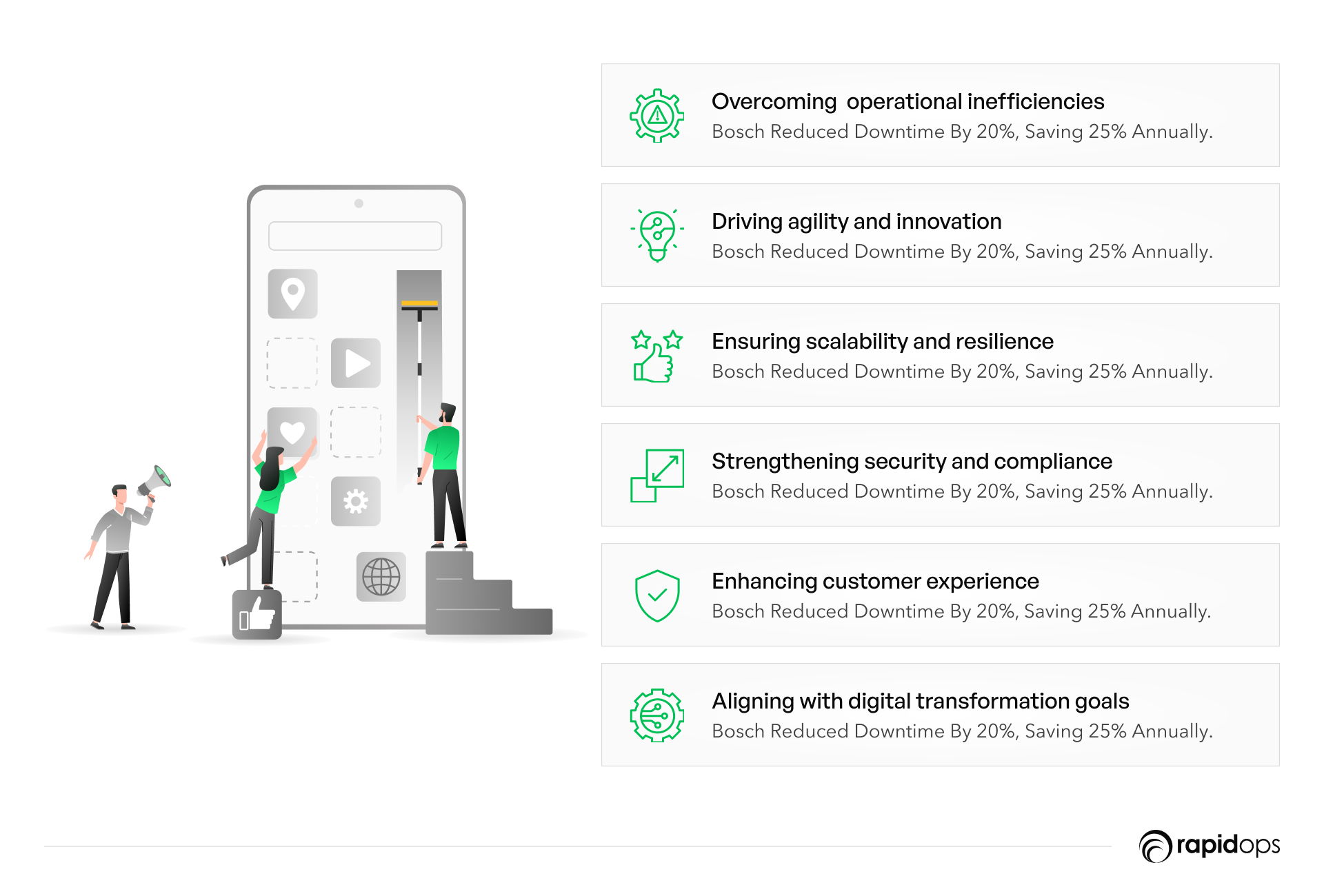
Overcoming operational inefficiencies
Legacy applications consume up to 60% of IT budgets, limiting resources that could fuel growth and innovation. These systems often suffer from frequent downtime, slow performance, and high maintenance costs, directly impacting business outcomes.
Why it matters
- Optimized efficiency: Application modernization services reduce operational costs by 20-30% through automation and process improvements.
- Continuous operations: Businesses that modernize achieve up to 99.9% system uptime, minimizing disruptions.
Case study: Bosch
Facing rising maintenance costs and production delays, Bosch adopted a cloud-native application modernization approach. By integrating IoT and AI-driven automation, they reduced downtime by 20% and saved 25% in operational costs, strengthening their competitive edge.
Driving agility and innovation
Modernizing applications enables businesses to quickly adapt to changing market demands. Legacy systems slow innovation, delay product launches, and limit scalability, leaving enterprises vulnerable to disruption.
Why it matters
- Faster market response: An effective application modernization strategy accelerates product launches by up to 30%.
- Increased innovation: Agile enterprises leveraging application modernization tools are 2.5x more successful in launching new offerings.
Case study: Walmart
Walmart modernized its eCommerce and supply chain platforms through scalable application modernization, cutting order fulfillment times by 23% and boosting peak-season sales by 30%.
Enhancing customer experience
Today’s customers expect seamless, personalized interactions. Legacy systems, with outdated interfaces and siloed data, fail to meet these expectations, leading to churn and lost revenue.
Why it matters
- Personalized engagement: AI-driven application modernization enhances real-time data processing, enabling hyper-personalized experiences.
- Stronger retention: Companies see a 20% rise in customer satisfaction and a 25% improvement in retention rates post-modernization.
Case study: Target
Target leveraged business-driven application modernization to personalize promotions, increasing app engagement by 50% and reducing checkout times by 15%.
Ensuring scalability and resilience
Business growth places enormous pressure on outdated systems. Legacy applications struggle to handle increased workloads, leading to service disruptions, revenue loss, and customer dissatisfaction.
Why it matters
- Seamless scalability: Cloud application modernization ensures systems adapt to demand fluctuations effortlessly.
- Improved reliability: Enterprises experience 15-20% fewer service disruptions with future-ready application modernization.
Case study: FedEx
By modernizing its logistics systems, FedEx ensured 99.9% uptime and managed a 25% increase in package volume during peak seasons without delays.
Strengthening security and compliance
Cybersecurity threats and evolving regulatory requirements make legacy system modernization essential. Outdated applications increase vulnerability, risking financial loss and reputational damage.
Why it matters
- Robust security: Application migration and modernization reduce cyberattack risks by 45%.
- Regulatory readiness: Businesses improve compliance adherence by 35%, avoiding costly penalties.
Modernized infrastructure safeguards critical data, mitigates risks and ensures organizations remain compliant with evolving industry standards.
Aligning with digital transformation goals
Future-ready enterprises prioritize digital transformation through modernization to integrate AI, IoT, and machine learning into their operations. Legacy systems lack the flexibility to support these innovations.
Why it matters
- Competitive edge: Modernized businesses are 4x more likely to successfully leverage emerging technologies.
- Smarter decision-making: 60% of leaders report improved real-time insights with enterprise application modernization.
Case study: Procter & Gamble
P&G modernized its supply chain, reducing disruptions by 30% and cutting production lead times by 15%, boosting market responsiveness.
Application modernization is a strategic imperative, not just a technical upgrade. Enterprises that embrace modernization drive efficiency, agility, and innovation, positioning themselves for long-term success. Investing in application modernization solutions today ensures resilience, scalability, and a competitive advantage in the digital future.
Core approaches to application modernization
Modernization is no longer optional, it’s the foundation for agility, competitiveness, and resilience in today’s fast-changing market. A well-defined enterprise modernization strategy ensures organizations can optimize performance, reduce costs, and stay ahead of industry shifts. However, selecting the right IT modernization strategy requires a clear understanding of available approaches, trade-offs, and long-term impact.
This breakdown of four key strategies provides clear, actionable insights to support confident, informed decision-making.
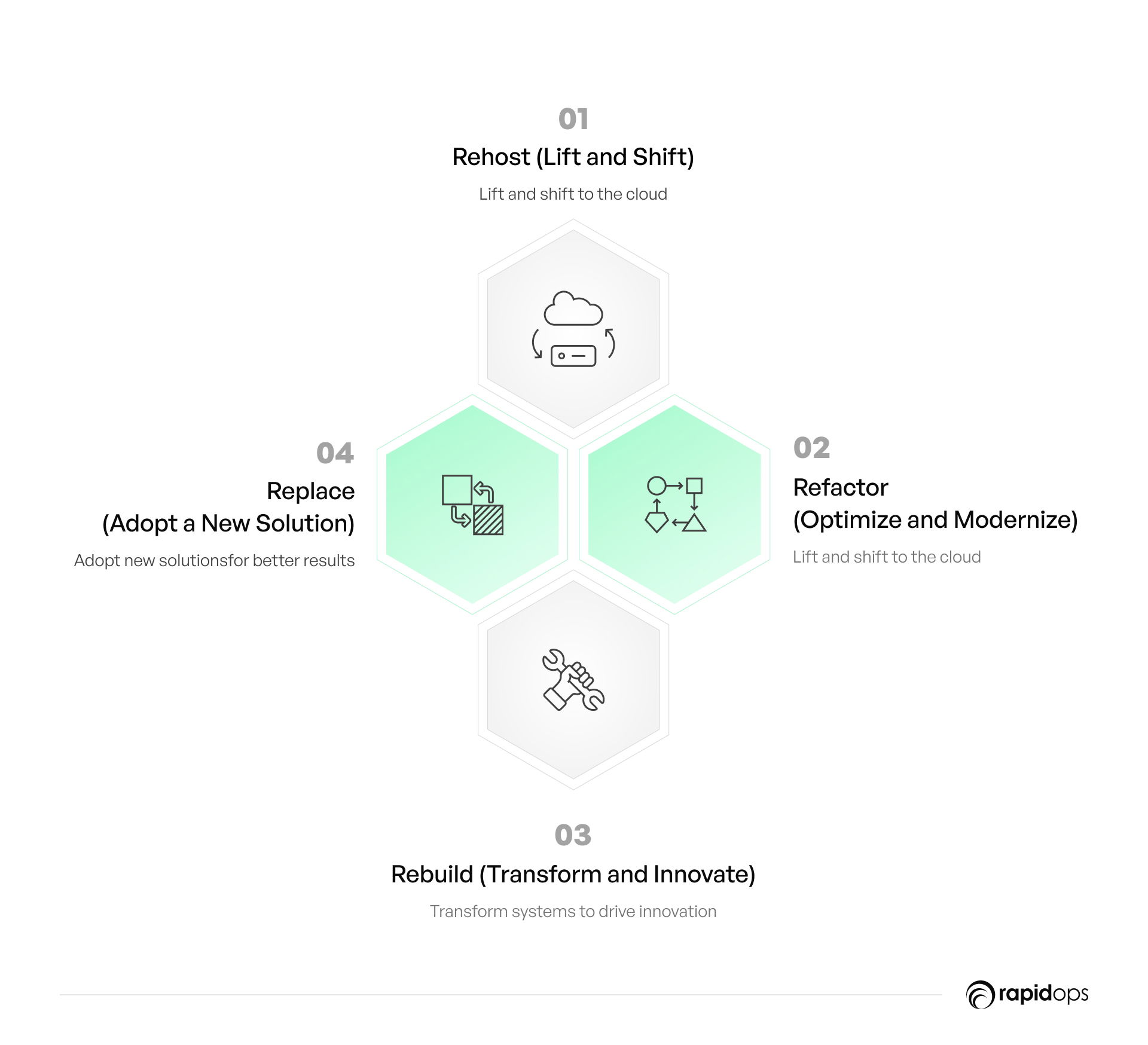
1. Want quick scalability with minimal disruption? Rehost (Lift and Shift)
What it is
Rehosting moves existing applications to a new environment, like the cloud, without altering their core architecture. This approach is fundamental to cloud application modernization and serves as a low-risk entry point for application migration and modernization efforts.
When to use it
- Time-sensitive scaling: Ideal for businesses facing immediate demand surges that legacy application modernization alone cannot handle.
- Cost-conscious scaling: Suitable when budgets limit extensive redevelopment efforts.
- High infrastructure costs tied to outdated on-premises systems.
- Inflexibility in meeting seasonal or unexpected demand spikes.
Pros
- Fast and low-risk migration.
- Minimal operational disruption during the transition.
Trade-offs for decision-making
- Benefit: Quick implementation with reduced upfront costs.
- Limitation: Does not optimize applications for advanced cloud-native capabilities, which may lead to future IT infrastructure modernization needs.
2. Need optimized performance without starting over? Refactor (Optimize and modernize)
What it is
Refactoring modifies the application’s code or architecture to enhance performance and leverage cloud-native features like auto-scaling and advanced analytics. A well-executed application modernization strategy ensures efficient integration of software modernization techniques for long-term success.
When to use it
- Performance-driven modernization: Ideal for systems that are resource-heavy or slow but still meet functional needs.
- Partial Optimization: When you want to modernize without the cost or time investment of a full rebuild.
Challenges it addresses
- Operational inefficiencies caused by legacy systems.
- Inability to utilize modern features like real-time analytics or dynamic resource scaling.
Trade-offs for decision-making
- Benefit: Retains core functionality while improving efficiency.
- Limitation: May not resolve deeper structural limitations, requiring further upgrades in the future.
3. Want long-term flexibility and scalability? Rebuild (Transform and innovate)
What it is
Rebuilding involves re-architecting the application entirely, often transitioning from monolithic systems to microservices for greater agility. This is a core component of enterprise application modernization and ensures a future-ready application modernization strategy that supports innovation.
When to use it
- Future-ready architecture: Ideal when existing systems no longer meet business needs or support innovation.
- Seamless integration: When businesses need to adopt advanced technologies like AI or IoT.
Challenges it addresses
- Legacy systems that stifle growth and innovation.
- Integration challenges with emerging technologies.
Pros
- Highly scalable, flexible, and future proof.
- Fully customizable to evolving business needs.
Trade-offs for decision-making
- Benefit: Long-term scalability and competitive edge through cutting-edge enterprise cloud transformation.
- Limitation: High initial investment of time and resources, with significant organizational change management required.
4. Need a Fresh Start with Modern Features? Replace (Adopt a New Solution)
What it is
Replacing involves discarding the legacy system entirely and adopting a new, off-the-shelf, or custom-built solution. This ensures full legacy system modernization with tailored application modernization solutions that align with evolving business goals.
When to use it
- Rapid modernization: When outdated systems are beyond repair or too costly to maintain.
- Adoption of advanced capabilities: When new features like AI-driven workflows or advanced security protocols are critical.
Challenges it addresses
- Costly maintenance and operational inefficiencies in legacy systems.
- Lack of compatibility with modern tools or platforms.
Pros
- Eliminates legacy system constraints.
- Provides access to advanced, ready-to-use solutions.
Trade-offs for decision-making
- Benefit: Immediate access to modern functionality.
- Limitation: High upfront costs and potential disruption during implementation.
Which modernization strategy fits your business
| Strategy | Pros | Cons |
| Rehost |
Fast and low-risk migration; Minimal operational disruption |
Does not optimize for cloud-native capabilities; May require future modernization |
| Refactor | Enhanced efficiency and compatibility with modern platforms; Improved scalability |
May not resolve deeper structural issues, requiring future upgrades |
| Rebuild | Highly scalable and flexible; Fully customizable to business needs; Future-proof |
High initial investment of time and resources; Significant organizational change management required |
| Replace | Eliminates legacy system constraints; Immediate access to modern, ready-to-use solutions |
Eliminates legacy system constraints; Immediate access to modern, ready-to-use solutions |
Making strategic decisions
Modernization is about more than improving systems, it’s about aligning technology with your business’s future. Each approach comes with its benefits and trade-offs, and the right decision depends on:
- Your goals: Quick scalability, long-term flexibility, or gradual modernization.
- Your resources: Budget, timeline, and organizational readiness.
By understanding the implications of each approach, you can modernize with confidence and turn legacy limitations into opportunities for growth and innovation.
Common challenges in application modernization
Modernizing legacy systems isn’t just a technical upgrade, it’s a business imperative. Companies that fail to modernize risk operational inefficiencies, security vulnerabilities, and losing their competitive edge. However, application modernization comes with its own set of enterprise modernization challenges that businesses must navigate carefully.
From technical debt in modernization to IT skill gaps, organizations face a range of IT modernization obstacles that can derail progress if not addressed strategically. This guide explores the most pressing application modernization challenges, shedding light on their impact and why overcoming them is crucial for success.
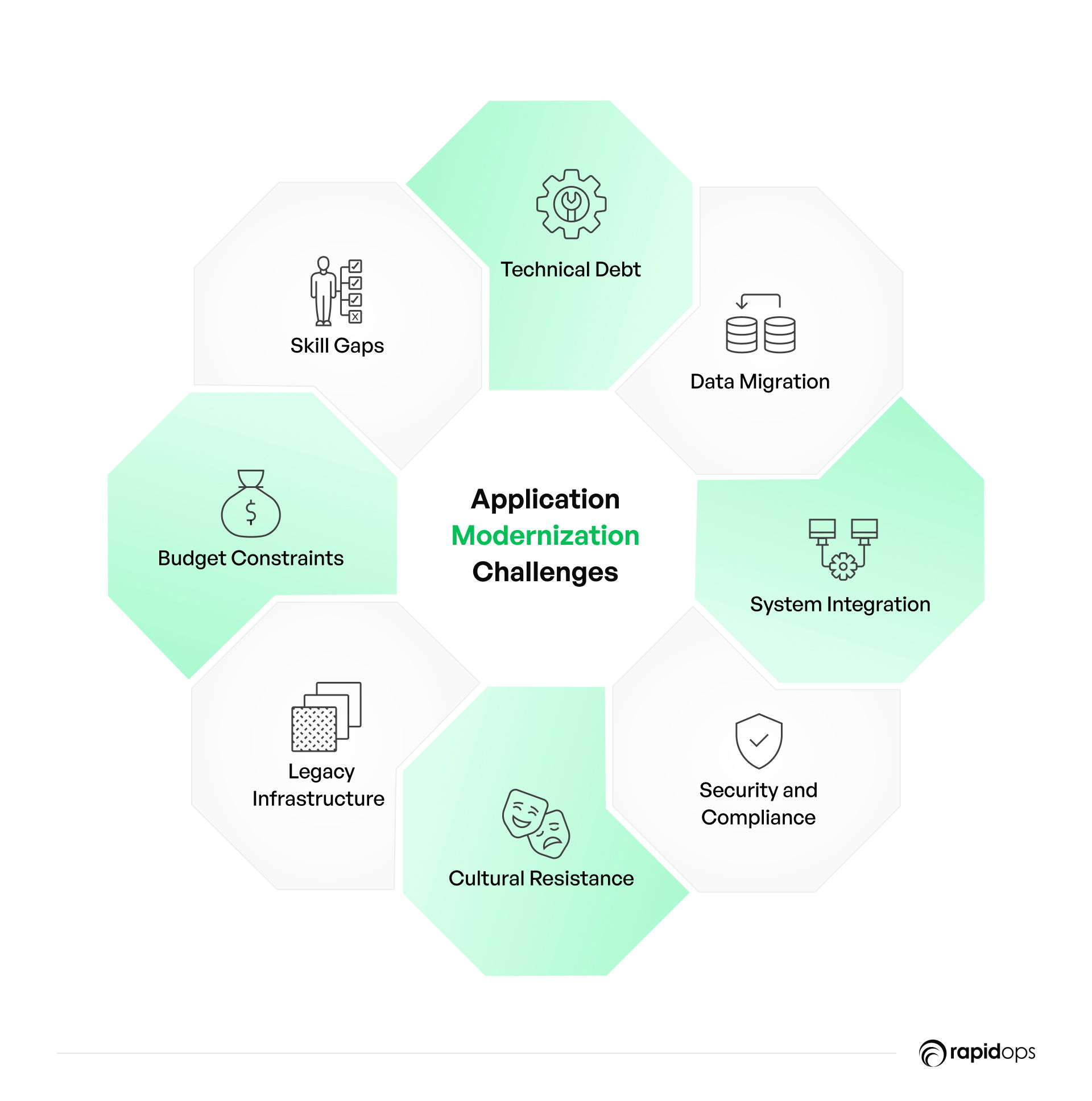
1. Technical debt: A hidden barrier to innovation
One of the most overlooked yet critical IT modernization pitfalls is technical debt—the accumulation of outdated code, patches, and quick fixes that make systems fragile and costly to maintain. Over time, this hinders scalability, drains resources, and limits innovation.
Many organizations allocate up to 40% of their IT budget to maintaining legacy systems instead of driving innovation. Without proactive management, technical debt slows down digital initiatives, leading to missed market opportunities.
Key roadblocks
- Legacy code that is difficult to update or integrate with new technologies.
- Increased operational costs and performance bottlenecks.
2. Data migration: The risk of disruptions and data loss
Data is the backbone of any digital enterprise, yet application migration challenges often pose significant risks. Moving critical data from outdated systems to modern platforms is a complex task fraught with data migration risks and solutions concerns, including security, integrity, and downtime.
With 60% of migration projects facing delays or budget overruns, organizations struggle with ensuring a smooth transition. Any failure in enterprise IT transformation can lead to compliance violations, operational disruptions, and loss of critical business intelligence.
Key roadblocks
- Risk of data loss, corruption, or downtime during migration.
- High costs and delays in large-scale data migrations.
3. System integration: Struggling to make old and new systems work together
Many organizations fail to anticipate the system integration challenges in IT, leading to fragmented operations and inefficiencies. Legacy systems often don’t communicate well with modern applications, creating challenges in modernizing applications that affect productivity and customer experience.
Studies show that nearly 70% of enterprise IT transformation hurdles stem from poor integration, causing bottlenecks in workflow automation and data sharing. Without a clear integration strategy, modernization efforts can create more complexity instead of solving existing problems.
Key roadblocks
- Incompatibility between legacy and modern applications.
- Increased complexity in managing disparate IT ecosystems.
4. Security & compliance: Rising cyber threats and regulatory pressure
Modernizing outdated infrastructure comes with cybersecurity risks in legacy systems, as older applications often lack the security measures needed to defend against modern threats. Additionally, compliance challenges in IT modernization can expose organizations to regulatory penalties if sensitive data is mishandled.
With cyberattacks targeting legacy systems increasing yearly, businesses must prioritize legacy system modernization risks to prevent breaches that could cost millions in fines and lost customer trust.
Key roadblocks
- Outdated security protocols that leave systems vulnerable to cyber threats.
- Compliance issues can result in financial and legal repercussions.
5. Cultural resistance: When your team pushes back on change
One of the biggest IT adoption challenges isn’t technical, it’s cultural. Employees accustomed to legacy systems often resist change, slowing down adoption and reducing the effectiveness of change management in digital transformation.
If leaders fail to address workforce concerns, overcoming application modernization barriers becomes significantly harder. Employees may view modernization as a threat rather than an opportunity, leading to friction and reduced efficiency.
Key roadblocks
- Resistance to new processes and workflows.
- Lack of proper training and communication from leadership.
6. Legacy infrastructure: The weight that holds you back
Aging infrastructure is a major roadblock to digital transformation. Legacy system modernization risks include high maintenance costs, lack of flexibility, and inefficiency. Many businesses find themselves trapped in outdated IT modernization challenges that prevent them from scaling or integrating new technologies.
Without a solid strategy for modernizing outdated infrastructure, companies risk falling behind competitors who leverage modern, agile solutions.
Key roadblocks
- High costs of maintaining and upgrading legacy hardware.
- Lack of scalability and integration with modern cloud-based solutions.
7. Budget constraints: Justifying the cost of modernization
Securing funding for modernization is a constant struggle. Many organizations hesitate to invest due to IT modernization budget challenges, fearing that costs may spiral out of control. However, delaying modernization often leads to higher long-term costs, as maintaining outdated systems becomes increasingly expensive.
The key lies in cost-effective application modernization strategies that demonstrate a clear ROI in IT transformation, ensuring stakeholders see the long-term value.
Key roadblocks
- Unclear cost-benefit analysis delaying investment.
- High upfront expenses associated with large-scale modernization projects.
8. Skill gaps: Bridging the expertise divide
Modernizing applications requires specialized skills, yet many organizations face IT skill gaps in modernization. Emerging technologies like cloud computing, devops, and AI demand expertise that internal teams may lack.
Without proactive IT workforce upskilling, businesses struggle to execute modernization projects effectively. Bridging expertise in application modernization is crucial to ensuring smooth transitions and long-term success.
Key roadblocks
- Shortage of skilled professionals in cloud computing and DevOps.
- Increased reliance on external vendors, leading to long-term dependency.
Turning challenges into opportunities
The road to modernization is filled with enterprise modernization challenges, but each obstacle also presents an opportunity to build a stronger, more resilient digital foundation. By proactively addressing IT modernization obstacles, organizations can unlock new efficiencies, improve security, and drive innovation.
A well-structured digital transformation strategy ensures businesses move beyond legacy constraints, empowering them to compete effectively in a rapidly evolving landscape. Overcoming IT modernization barriers isn’t just about technology—it’s about enabling future growth and success.
How to spot a modernization partner you can trust
Choosing the right partner for application modernization is a critical decision that can make or break your digital transformation. Here are clear, actionable steps to ensure you select a partner who is equipped to drive your business forward efficiently and effectively.
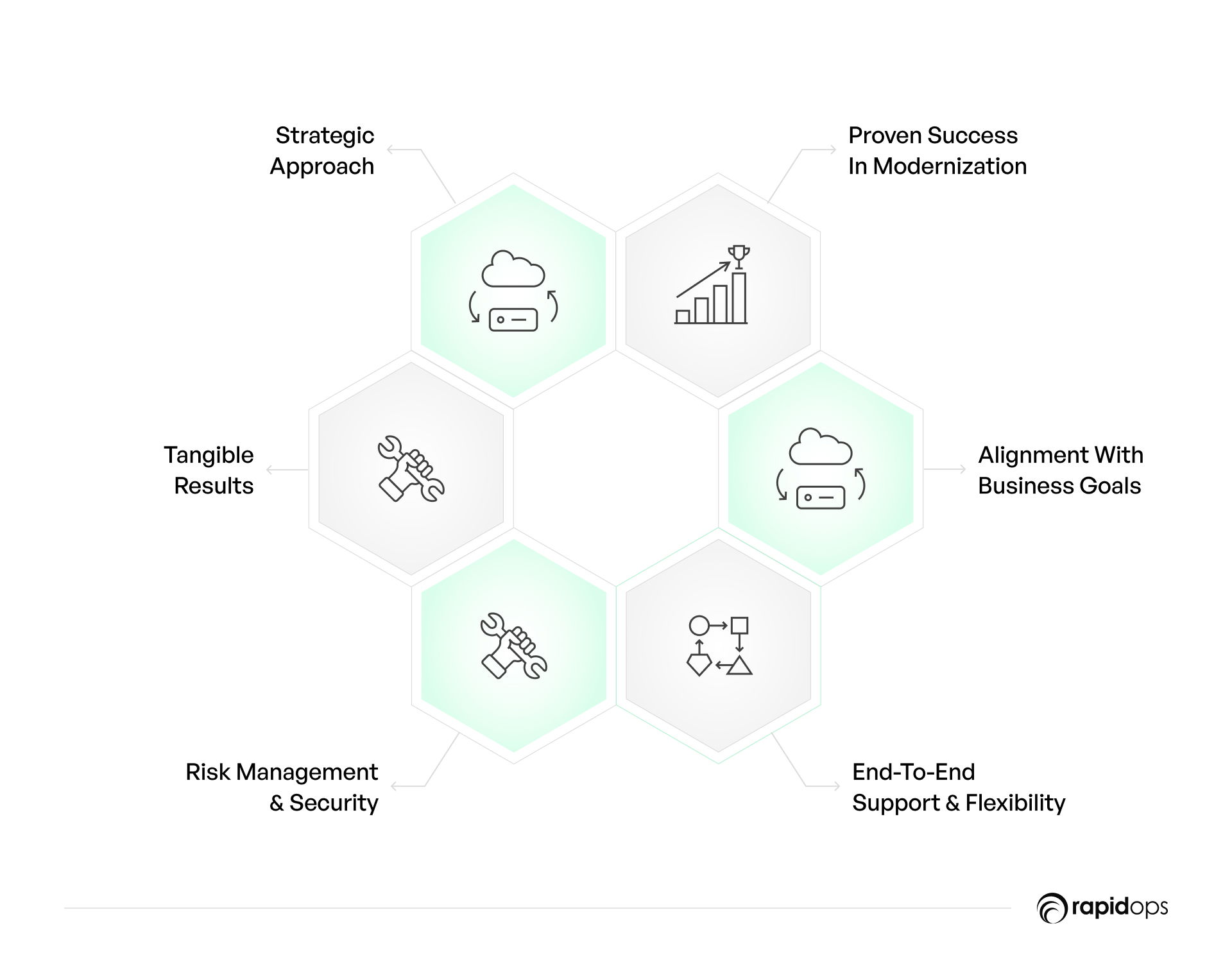
Look for proven success in similar modernization projects
An inexperienced partner can lead to costly mistakes, delays, and operational disruptions. Focus on partners with a strong track record in cloud migration, system integration, or legacy system transformation.
- Action: Request detailed case studies showing measurable results, such as a 20% reduction in system downtime or 30% cost savings. Ask how they overcame specific challenges and whether those scenarios align with your business needs.
Ensure alignment with your business objectives
Your partner should understand your business goals and align their technical solutions to drive tangible outcomes. Modernization is not just about technology—it must translate into better efficiency, faster time-to-market, and improved customer experience.
- Action: Ask how their approach will impact your bottom line. For example, “Can you provide examples of how you helped previous clients reduce operational costs or improve customer experience through application modernization?”
Look for end-to-end support with flexibility
Modernization is a continuous process. You need a partner who offers end-to-end IT modernization services, from initial assessment to implementation and long-term support. Additionally, they should be adaptable to your evolving needs as your business scales.
- Action: Inquire about their ongoing support structure and flexibility. “How do you adapt your modernization strategies to meet changing business needs over time?”
Evaluate their risk management and security practices
Security and compliance are non-negotiable in today’s digital landscape. Choose a partner who ensures that your systems are secure during and after modernization while also meeting industry regulations.
- Action: Ask how they manage security and compliance risks. “What steps do you take to ensure the security of systems during the modernization process? How do you ensure compliance with industry standards such as GDPR, HIPAA, or SOC 2?”
Assess their ability to deliver tangible results
Modernization should lead to measurable improvements in performance, cost efficiency, and customer satisfaction. A good partner should be able to show clear, data-backed results from previous projects.
- Action: Request case studies or success stories that demonstrate measurable outcomes. “Can you share a detailed case study showing how your modernization efforts improved system performance or customer satisfaction for a client?”
Prioritize partners with a strategic modernization approach
Look for partners who take a strategic, business-driven approach to modernization. They should understand the long-term vision for your company, ensuring that the systems they build today will support future growth and scalability.
- Action: Ask about their strategic approach. “How do you approach phased modernization, and how do you ensure that the systems you implement today will scale as our business grows?”
The right modernization partner doesn’t just solve problems, they empower your business to evolve, adapt, and thrive. With deep expertise, strategic guidance, and a focus on long-term success, they help ensure that your digital transformation delivers lasting value.
Shaping tomorrow’s success through application modernization
The decisions you make today will define your organization’s ability to compete, scale, and innovate in the future. Application modernization isn’t just about upgrading outdated systems, it’s about building a scalable, agile, and future-proof business that can adapt to evolving market demands.
But where do you start? Legacy applications often limit efficiency, hinder digital transformation, and increase costs. The key is to develop a modernization strategy that aligns with your business goals, integrates AI, cloud, and automation, and ensures long-term resilience without disrupting operations.
This is where Rapidops comes in. With over 15 years of experience, we’ve helped businesses across retail, manufacturing, and logistics transform their legacy systems into modern, scalable solutions that drive efficiency, competitive advantage, and long-term growth. Our approach goes beyond technology, we act as your strategic partner, ensuring every modernization effort aligns with your business’s vision.
The next step is simple. Let’s explore how a tailored application modernization strategy can help your business scale faster, reduce costs, and stay ahead of the curve. Schedule a free consultation with our experts to gain clear insights and practical next steps for your modernization journey.
Frequently Asked Questions
What happens if you delay application modernization?
How can you leverage data in the modernization process to drive strategic decision-making?
How do you mitigate the risks of data loss during application modernization?
What are the hidden costs of application modernization that you should be prepared for?
How do you manage the complexity of integrating legacy systems with modern solutions?
What’s Inside
- What is application modernization? A strategic imperative for business leaders
- Why application modernization matters: The business impact
- Core approaches to application modernization
- Common challenges in application modernization
- How to spot a modernization partner you can trust
- Shaping tomorrow’s success through application modernization




